Optimizing Small Bathroom Spaces
Optical Effects
Mirrors and careful lighting are key to creating the illusion of space, but even more important, they are key to enhancing the reality of a bathroom’s day to day function. Most of the furniture highlighted in this continuing education course is available with matching mirrors or mirrors built into the cabinets or on side panels. As mentioned earlier, small bathrooms benefit just as much or more than other rooms from the use of LED lighting, from both a functional and an environmental viewpoint. Indirect non-glare LED light is used to advantage when set into a mirrored cabinet, or around a mirror, brightening the room and illuminating the face perfectly.
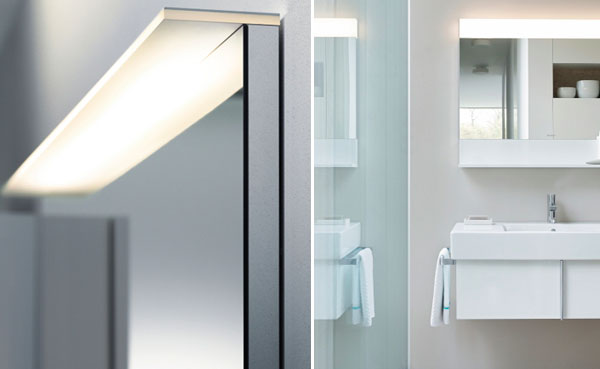
Photos courtesy Duravit AG
Two views of a mirrored cabinet incorporating LED lighting.
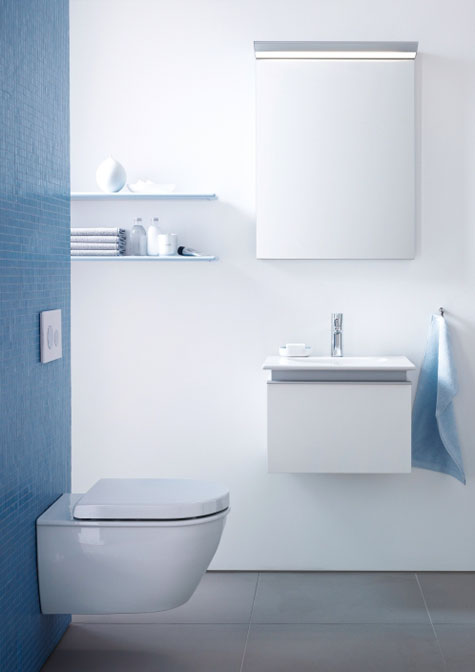
Photo courtesy of Duravit AG
Azure blue introduces a colorful accent to a small bathroom that appears larger through the use of light colors, large-format tiles, LED lighting and abundant open space.
Combining Health and Luxury
A new toilet-bidet unit designed in Germany is a good example of a “combination” unit that illustrates not only multi-function for a small space but also just how much function is possible when thoughtful design is acting on every detail. In other parts of the world, bidets are considered essential and taken for granted in homes of every size. But until recently many Americans only encountered bidets in luxury hotels. Also much more common elsewhere are “shower toilets,” combination toilets-bidets equipped with stainless steel spray wands and dryers, for the most natural hygiene possible—washing with water.
That these units can add luxury to a small space is perhaps obvious, but they are also very practical additions to a small, multi-functional, universal design bathroom. For anyone with physical challenges, from sore muscles to mobility issues, a toilet-bidet is realistic, useful equipment. For everyone else, it can take a small space from personal hygiene to personal spa.
Every detail of the design and operation of this state-of-the-art unit has been carefully considered. All controls and fittings are invisible inside the ergonomic form, available in a range of sizes, including low projection and extra slim models for very small spaces, some only 24 inches in depth. Control elements, although concealed, are easily accessible. The stainless steel spray wand—specially treated with an anti-microbial coating—can be operated individually in any position, or a moving spray can be activated. Spray wands are automatically self-cleaned before and after each use.
A simple, easy to use remote control lets the user instantly operate and customize all functions, including water temperature, seat temperature, spray position, dryer temperature, and water pressure, which can be increased or decreased any time during use. The keypad can store personal preferences for different users, has child safety controls, and is illuminated for nighttime use, as is the unit bowl itself. The night light’s LED color is carefully calibrated so as not to interrupt melatonin levels that contribute to good sleep.
Building a little luxury into the daily routine this way has its practical side, too. The gently closing lid and seat have easy-clean surfaces, and are also easily removable for complete cleaning. The spray nozzles are easily cleaned and replaceable.
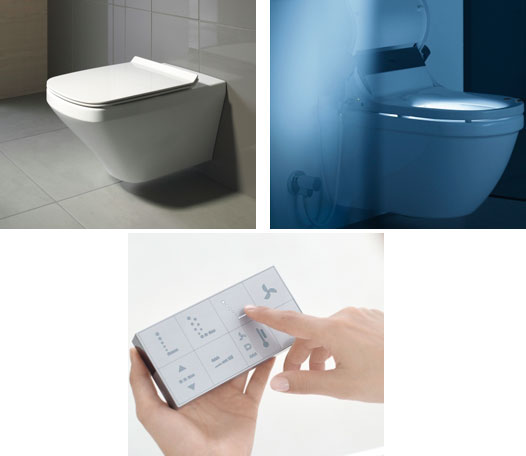
Photos courtesy Duravit AG
An innovative toilet-bidet combination builds high function, thoughtful details and definite luxury into daily routine, in spaces large or small
Small but Accessible
Contemporary trends may be driving down the size of bathrooms, but these small bathrooms will still have to be accessible—not just in places mandated through ADA, and not just for people with defined physical or mental disabilities of all ages, including large numbers of returning veterans. Universal design is increasingly recognized as improving quality of life for other large cohorts of the population as well, such as millions of people in the large baby boom generation, either downsizing and moving, or making changes in their home for aging in place, and in general much more active, prosperous and demanding of high quality than previous generations. Of course, young, mobile, single people, multi-generational households, and families with little kids appreciate many aspects of universal design, too, so the target market seems to be as “universal” as the design.
Small bathrooms in residences can sometimes take design tips from the hospitality industry, where bathrooms are considered the room that makes the strongest customer impression, but high quality accessibility is both profitable and required by law. For example, the open shower plan discussed above offers excellent ease of access, and wall-hung units such as toilets, consoles and sinks can be mounted at required ADA heights.
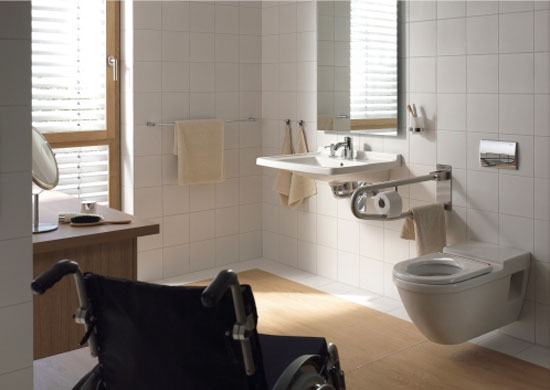
Photo courtesy of Duravit AG
Informed design creates a bathroom space with style, comfort and functionality for every member of any family at any age.
Small/Sustainable
As mentioned earlier, smaller spaces require proportionally less resources to build, operate and maintain over time, so “small” is in itself an important step towards sustainability. But by today’s standards of environmental responsibility, even the most attractive, functional small bathroom must still be manufactured and designed for maximum sustainability. First, the bathroom itself should make intelligent use of energy and water. Second, there are many opportunities in the manufacture of bathroom furniture products to make decisions that will determine a long-term low impact on the environment.
In the bathroom itself day to day, water efficiency and lighting are two key areas. Toilet-flushing uses more water in households than any other single activity, about 27 percent in an average home. Toilets with the EPA WaterSense label can save from 70 to 80 percent of that. Dual-flush toilets can save even more and should be an essential part of a sustainable bathroom of any size. Bathing is another water-intensive daily activity. On average, a shower consumes less than one third of the water volume required to fill a bath, so the inviting, attractive showers discussed in this course are water-savvy as well. But bathtubs are also available that can conserve water, including models that use less space and have comparatively low filling volume.
Using LED lighting for room lighting, controls, lighted bathtubs, and all other applications provides natural, even, pleasing light while generating power savings of up to 80 percent compared with halogen lights.
But beyond these basics, the most sustainable products feature other details, such as fired-in coatings for ceramics that not only make bathroom surfaces more hygienic and easier to clean, but save resources over time because much less cleaning agent and additional water are used.
Some of the areas to focus on when evaluating a manufacturer’s commitment to designing and building sustainable products and maintaining a water-saving and energy-efficient operation include:
• Use of sustainable materials such as native wood sourced from certified, sustainably managed forests.
• Purchased parts, materials and chemicals used in manufacturing are themselves produced to certified environmental standards
• All products comply with or exceed recognized third party requirements (e.g., the “CE” mark certifying compliance with EU directives)
• Products are subjected to rigorous safety and environmental testing
• Product materials can be recycled, even in the case of complex materials like ceramics (e.g., can be used as wear-resistant material in road construction) or sanitary acrylic (e.g., components can be recycled into varnishes). Other materials such as ABS plastics, board materials, fittings and glass can be recycled for use in new bathroom furniture.
• Recycling is also emphasized in manufacturing process.
• Intelligent packaging is used, made of 60 percent recycled paper and with minimum additions like staples.
• To save water and reduce emissions (CO2, pollutants, noise) to a minimum, technically sophisticated low-pollutant product facilities are used, and heat is generated through waste wood recycling and heat recovery from ceramic manufacture. Water is recycled with wastewater treatment facilities, including plants that enable a reduction in the amount of treatment chemicals used by up to 20 percent.
Putting it All Together
At the beginning of this course, we showed you a sketch of a small, challenging space. Here are three ways that some of the elements discussed in the course can combine for a comfortable, stylish, fully functional bathroom.

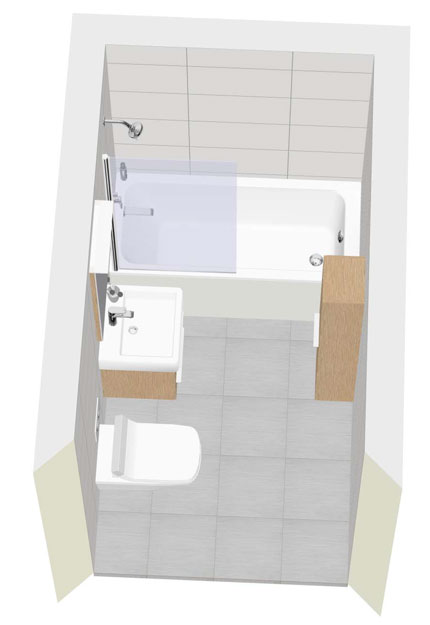
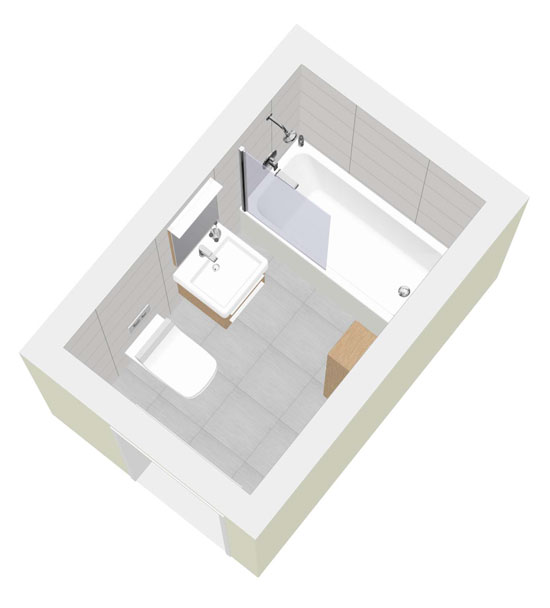
Images courtesy Duravit AG
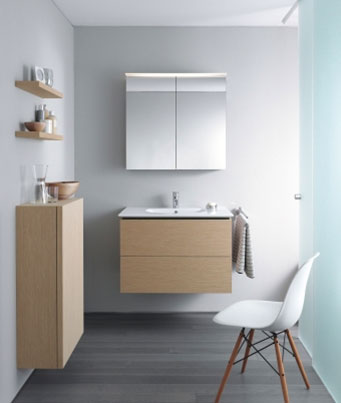
Photo courtesy of Duravit AG
A small space packed with good ideas, including a vanity unit, semi-high cabinet, decorative wall boards, and a mirror with indirect, non-glare LED light.
Bathrooms are essential to comfort and well being. They are a necessary part of every day, so they can either contribute to health and well being every day, or detract. With thoughtful design in every inch and detail, small bathrooms can provide the function, sustainability and flexibility that make bathrooms great—and possibly even the bliss and the sanctuary and the glamour.
 |
Founded in 1817 in the heart of the Black Forest, Duravit is a leading manufacturer of ceramic sanitaryware, bathroom furniture, whirlpool tubs and wellness products. Duravit’s collaborations with internationally renowned designers such as Philippe Starck, Norman Foster and sieger design yield forward-thinking, environmentally-conscious and award-winning products that bring the bathroom to life. For more information please contact Duravit USA, Inc.: 888-DURAVIT or pro.duravit.us. |








